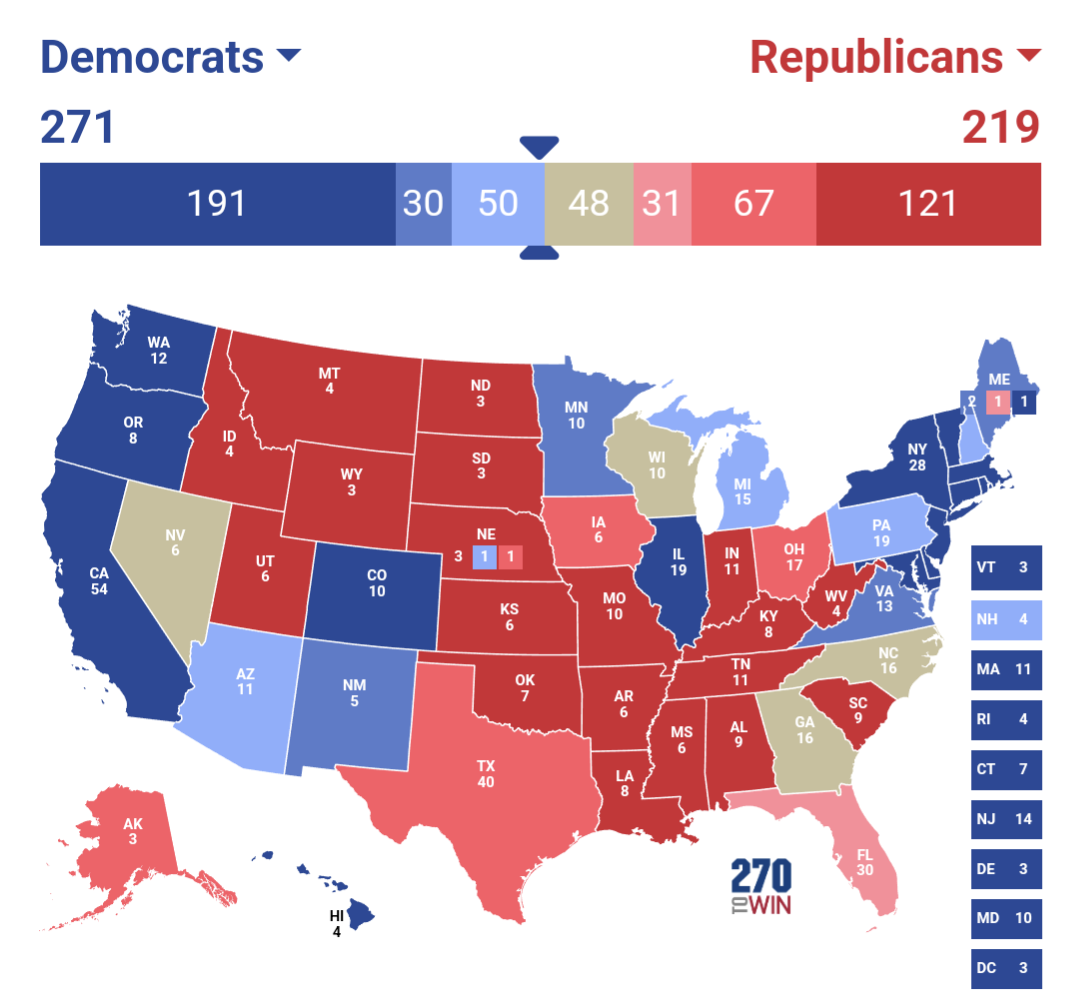Yesterday, I wrote this post on Threads
People who know me and follow me understood my point.
But there were a lot of not nice comments regarding how I don't understand how elections work.
In fairness, my post is a lot less far-fetched than some of the nonsense Trumpspiracy theorists post, so missing the point (and assuming I'm one of them) isn't without merit.
Here's the data I shared.
Michigan:
Trump won in 2016 with 47.3%
Trump lost in 2020 with 47.8%
Pennsylvania:
Trump won in 2016 with 48.2%
Trump lost in 2020 with 48.8%
Wisconsin:
Trump won in 2016 with 47.2%
Trump lost in 2020 with 48.8%
Arizona:
Trump won in 2016 with 48.1%
Trump lost in 2020 with 49.1%
The Electoral College is a terrible way to elect a President. It says that the popular vote of a country isn't good enough to elect the President, but the popular vote of a few states is.
But, at least, it makes win probability math easier…in some ways.
Each candidate has zero path to victory without winning most of these swing states.
The other day, I put out this (admittedly qualified) post about the worst case map for Biden.
You can doubt me if you want (and it is too early for me to meaningfully argue with you if you do) but here's what I posted a few months in advance of the 2020 election:
That “worst case” map ended up being very close to the worst case.
On its face, Trump increasing his percentage in every swing state from 2016 to 2020 could be concerning. It's hard to believe, admittedly.
But my job is to analyze the data, not feel about it.
The difference between 2016 and 2020, of course, was the third-party presence. Given that voters from election-to-election are very consistent, it's not hard to see where 2016’s third-party voters leaned: anti-Trump.
In 2016, those “double-haters” (liked neither Clinton nor Trump) favored Trump or third-party.
In 2020, they favored Biden.
As of now, Kennedy, though not well known among registered voters, is polling in the double-digits in many good polls in many swing states.
I'll admit, if Kennedy + Third-Parties pull 8% or more, Trump is favored in many swing states. Enough to make the election very close.
But I don't think that will happen.
It goes a little off topic, but US Elections are weird, and we have a known third-party underperformance phenomenon.
The short version is, because many pollsters actively disallow voters from choosing “undecided” many say they “support” a third-party candidate they may have never even heard of - or doesn't exist.
As it pertains to poll data, this isn't as big of a problem as you may think, but it makes forecasting harder.
And it requires a skill practicing experts in the field do not have: understand the difference between polls and forecasts.
Many people do vote third-party. Separating an actual third-party voter from a “I don't like either major candidate so I'll say this unknown person” is not easy. But it's not that hard, either.
The best comp for 2024, despite the names on the ballot, is not 2020.
It is 2016.
Neither major candidate is well-liked, and there will be a more substantive third-party push in 2024 than 2020.
Based on how polled “Kennedy” voters lean - towards Democrats - Biden's (and downballot Dems) ability to get those “double haters” to swallow their pride and keep Trump out of office will determine the election.
The junk scientific analysis of “historical trend” is for the winner of the Presidency to have “coattails” that pull candidates in swing districts/states to victory. In 2024, those coattails may work backwards: coming from good Senate Candidates, and/or bad Governor Candidates.
It's not an oversimplification to say that swing states decide the election.
Unfortunately, it's also not an oversimplification to say that a few hundred thousand swing voters in those swing states will decide the election.
For Biden to be favored - a scenario I currently believe is true - third parties need to pull less than 5% in the swing states. I think that's the path we're on.
But I'll have more confident analysis in September, when Dems start actively campaigning (and people come to terms with Biden will probably be the nominee).
Poll data is moving in a concerningly clickbait direction. My poll averages will be far more restrictive than in past years.
But if combined third-party support is coming under ~7% by September-October, then third-parties will finish under 5%, which means Ds are favorites, and not a small one.








